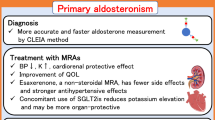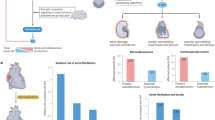Abstract
Primary aldosterone excess or hyperaldosteronism is an important cause of hypertension which, when associated with an aldosterone secreting adenoma, is amenable to surgical cure. The biochemical hallmarks of the condition are a relative excess of aldosterone production with suppression of plasma levels of renin (a proxy for angiotensin II, the major trophic substance regulating aldosterone secretion). This combination of a high aldosterone and a low renin is however more commonly associated with ‘nodular hyperplasia’ of the adrenal glands, a condition not improved by surgery and variably responsive to the effects of the mineralocorticoid antagonist, spironolactone. Until recently the prevalence of either form of secondary hypertension has been thought to be low such that few clinicians ‘hunted’ for it in the absence of hypokalaemia (the traditional clue for the syndrome). This view has been challenged, firstly by the realisation that no more than 50% of such patients will have a low plasma potassium and secondly by the assumption that a ‘normal’ plasma aldosterone is in fact inappropriately elevated if the renin level is low. A single measurement of the ratio of aldosterone to renin levels is claimed to be highly predictive of patients who will have primary aldosterone excess. This paper examines the logic behind such claims and presents evidence from the literature that an abnormal ratio is simply a different description of the low renin state and that such patients do not necessarily have mineralocorticoid hypertension. Most patients ‘discovered’ by this test will have what many call low-renin hypertension, a condition not amenable to specific therapy. Claims that they are peculiarly sensitive to the hypotensive effects of spironolactone have not been tested in controlled trials. The test would however be expected to pick up those individuals with true Conn's syndrome but such patients remain too few in number to justify widespread use of an expensive screening test.
This is a preview of subscription content, access via your institution
Access options
Subscribe to this journal
Receive 12 digital issues and online access to articles
$119.00 per year
only $9.92 per issue
Buy this article
- Purchase on Springer Link
- Instant access to full article PDF
Prices may be subject to local taxes which are calculated during checkout
Similar content being viewed by others
References
Ferriss JB et al. Low—renin (‘primary’) hyperaldosteronism differential diagnosis and distinction of subgroups within the syndrome Am Heart J 1978 95: 641–658
Conn JW . Primary aldosteronism, a new clinical syndrome J Labo Clini Med 1955 45: 3–17
Young WF et al. Primary aldosteronism: diagnosis and treatment Mayo Clinic Proc 1990 65: 96–110
Padfield PL et al. The myth of idiopathic hyperaldosteronism Lancet 1981 2: 83–84
Radin DR, Manoogian C, Nadicr JL . Diagnosis of primary hyperal-dosteronism: importance of correlating CT findings with endocrinologic studies Am J Roentgenol 1992 158: 553–557
Spark RF, Melby JC . Aldosteronism in hypertension: the spironolactone response test Ann Intern Med 1968 169: 685–695
Neville AM, O'Hare MJ . The human adrenal gland: aspects of structure, function and pathology. In: James VHT (ed) The Human Adrenal Gland, Academic Press: London 1979
Vallotton MB . Primary aldosteronism. Part 1 Diagnosis of primary aldosteronism Clin Endocrinol 1996 45: 47–52
Padfield PL et al. Is low-renin hypertension a stage in the development of essential hypertension or a diagnostic entity? Lancet 1975 1: 548–550
Davies DL et al. Aldosterone and its stimuli in normal and hypertensive man: are essential hypertension and primary hyperaldosteronism without tumour the same condition? J Endocr 1979 81: 79–91
Wisgerhof M, Carpenter PC, Brown RD . Increased adrenal sensitivity to angiotensin II in idiopathic hy-peraldosteronism J Clin Endocrinol Metab 1978 47: 938–943
Kisch ES, Dluhy RG, Williams GH . Enhanced aldosterone response to angiotensin II in human hypertension Circulation Res 1976 38: 502–505
Brown JJ et al. Comparison of surgery and prolonged spironolactone therapy inpatients with hypertension, aldosterone excess, and low plasma renin BMJ 1972 2: 729–734
Ganguly A, Luetscher JA . Spironolactone therapy in primary aldosteronism: diagnostic and therapeutic implications. In: Sambhi MP (ed) Systemic Effects of Antihypertensive Agents Stratton Intercontinental Medical Book: New York 1976 pp 383–392
Carey RM et al. The syndrome of essential hypertension and suppressed plasma renin activity. Normalization of blood pressure with spironolactone Arch Intern Med 1972 130: 849–854
Hiramatsu K et al. A screening test to identify aldosterone-producing adenoma by measuring plasma renin activity Arch Intern Med 1981 141: 1589–1594
Gordon RD . Mineralocorticoid hypertension Lancet 1994 344: 240–243
Gordon RD et al. Primary aldosteronism and other forms of mineralocorticoid hypertension. In: Swales J (ed.) Textbook of Hypertension Blackwell Scientific: Oxford 1994 pp 865–892
Stowasser M . Primary aldosteronism: revival of a syndrome J Hypertens 2001 3: 363–366
Lim PO et al. High prevalence of primary aldosteronism in the Tayside hypertension clinic population J Hum Hypertens 2000 5: 311–315
Lim PO, Jung RT, MacDonald TM . Raised aldosterone to renin ratio predicts antihypertensive efficacy of spironolactone: a prospective cohort follow-up study Br J Clin Pharm 1999 48: 756–760
Kaplan NM . Cautions over the current epidemic of primary aldosteronism Lancet 2001 357: 953–954
Mill JS . Analysis of the Phenomenon of the Human Mind, by James Mill vol 2, London: 1869
Author information
Authors and Affiliations
Rights and permissions
About this article
Cite this article
Padfield, P. Primary aldosteronism, a common entity? the myth persists. J Hum Hypertens 16, 159–162 (2002). https://doi.org/10.1038/sj.jhh.1001321
Received:
Accepted:
Published:
Issue Date:
DOI: https://doi.org/10.1038/sj.jhh.1001321
Keywords
This article is cited by
-
The ovarian cycle as a factor of variability in the laboratory screening for primary aldosteronism in women
Journal of Human Hypertension (2009)
-
Prevalence of primary hyperaldosteronism in mild to moderate hypertension without hypokalaemia
Journal of Human Hypertension (2006)
-
Aldosterone excess and essential hypertension
Journal of Human Hypertension (2002)



